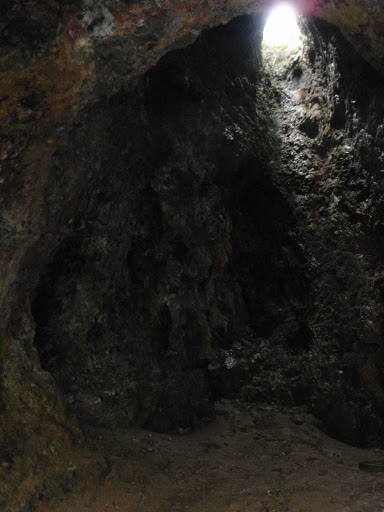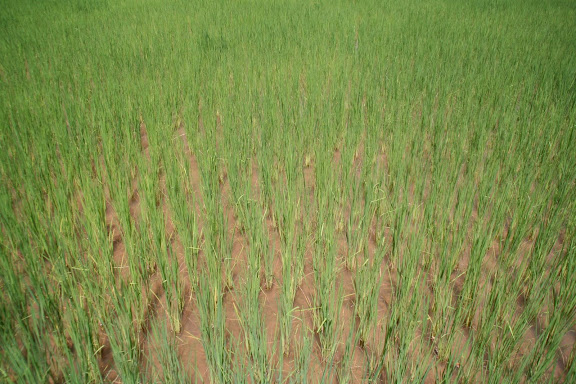Plain of Jars & “The Secret War in Laos”
Laos, Learned something new today, Reviews, RTW: 2007-2008, Southeast Asia — By Kelly on August 3, 2008 12:26 AMMost visitors come to the Xieng Khuang province to visit the mysterious Plain of Jars, a large group of historic cultural sites containing thousands of stone jars, which lie scattered throughout plain. *Archaeologists believe that the jars were used 1,500–2,000 years ago, by an ancient Mon-Khmer race whose culture is now totally unknown. Most of the excavated material has been dated to around 500 BC–800 AD. Anthropologists and archaeologists have theorized that the jars may have been used as funeral urns or perhaps storage for food. Lao stories and legends claim that there was a race of giants who once inhabited the area. Local legend tells of an ancient king called Khun Cheung, who fought a long, victorious battle against his enemy. He supposedly created the jars to brew and store huge amounts of lao rice wine to celebrate his victory. *Wikipedia
The jars now lie amidst thousands of unexploded bombs left behind by the US Secret War in Laos in the 1960s. The Plain of Jars remains one of the most dangerous archaeological sites in the world. Unexploded bombs (UXO), in particular cluster munitions (bombies), still cause injuries every week. Visitors can safely visit only three sites, designated Jar Sites 1, 2 and 3, as long as they follow the designated paths and adhere to warning signs.
We took a 3 day tour which involved 2 days of transportation and 1 day at the jars. It took us 8 hours by minivan from Luang Prabang to Phonsaven. I visited Site 1 and Site 2; however, I missed out on seeing Site 3 after my catastrophic incident. We were walking through a rice paddy field (see photo on right) when I slipped on the narrow muddy path and fell straight into a rice paddy! For those of you that do not know, a rice paddy field is a flooded parcel of land used for growing rice. I can tell you from my experience inside one, that it feels like you are in a muddy swamp and it’s hard to get out of it! This story of my clumsiness would be much funnier had I not been wearing my expensive digital SLR camera around my neck at the time of my fall which is now broken! Luckily I prepared for my inevitable falls by taking out insurance on my camera. I am in the process of figuring out how to get it repaired and back to me ASAP! In the meantime I will be using my backup waterproof camera.
Virtually every town and village in the Xieng Khuang Province was bombed between 1964-1973. Today the awesome beauty of the mountains and valleys is overshadowed by bomb craters, very few trees, and a huge quantity of UXOs . This province is the most heavily contaminated with UXO in Laos and walking off paths is extremely inadvisable.
In the picture to the left, Jane and I are inside a huge bomb crater.
Upon entry into site one, a large red and white sign with the with the letters MAG caught my attention. The sign informed us that MAG (Mine Advisory Group) has performed Unexploded Ordinance (UXO) clearance on this site. The sign instructed that the areas between white rocks are safe to walk on and advices one to only walk in these area. On site 1 alone, 127 UXOs have been found and removed.
Prior to arriving in Laos, I knew nothing of UXO, very little about the Vietnam War and I had never heard of a secret war in Laos. My curiosity has since been sparked and I have spent much time researching these topics. I am currently reading a book “The Ravens: Pilots of the Secret War of Laos” by Christopher Robbins, and I am learning all about a whole other war that was going on in Laos simultaneously with Vietnam. I visited the MAG (Mine Advisory Group) office in Phonsaven, where I gathered much of the statistics I report below. I also watched the Australian documentary called “Bombies” which was both informative and heartbreaking. A fellow US traveler, AD from North Carolina, shared with me the information he has learned as well. Thanks AD for sharing your knowledge with me and I credit you for much of the information below.
I am sure that there are many of you out there that were like me know nothing of these topics. I now feel compelled to share with you all what I have learned regarding the United States’ “Secret War” in Laos. Some of you may already know the facts, and others may not want to know. But it’s a story that I believe needs to be told, especially to Americans. It’s not just a sad chapter from our history, but is a daily concern that we may, as individuals or a nation, eventually choose to address.
Believe it or not, the little country of Laos has the dubious distinction of having been the most bombed country in the history of warfare – by the USA. More specifically, is one of the most heavily bombed provinces in the most heavily bombed country per capita in the world. After the French were expelled from Indochina in 1954, several Communist groups emerged to attempt to govern various SE Asian countries. In Laos, the country was split between the supporters of the monarchy and the Pathet Lao, who were determined to bring Laos into the Communist world. Supported by North Vietnam, China and the Soviet Union, the Pathet Lao were concentrated in NE Laos, but ventured into this central area on their way to the royalist capital in the south, Luang Prabang.
The US was in the thralls of the Red Fear, and, even before making a major move in Vietnam, began sending not just advisers but planes and bombs into Laos. It should be noted that both the USA and Vietnam signed the Geneva Accord of 1962, which recognized the neutrality of Laos and forbade the presence of foreign military personnel in it. This is why the US war in Laos was a secret war and both the USA and North Vietnam denied they had troops in Laos. The Ravens were the American pilots in Laos, all volunteers, who flew through heavy ground fire to identify targets and call in air-strikes. Their mission was top-secret. They wore no uniforms and carried no identification, and flew unmarked planes.
Later, this effort would be focused on, and justified by, trying to disrupt the infamous “Ho Chi Minh Trail”. The trail consisted of a network of roads, paths and rivers running through Laos and Cambodia, used to smuggle people and equipment from North to South Vietnam. The trail was hidden from aerial observation by both natural and man-made camouflage. US strategy was therefore to subject large areas to intensive bombardment. This entirely separate war went on secretly in central Laos, far from the Vietnam border, as the US attempted to push back the Red Tide.
According to US Defense Department records (US bombing data was made available to UXO Laos in 1997), between 1964 and 1973, almost 2 million tons (that’s 4 billion pounds) of “ordinance” (bombs) were dropped on Laos, more than double what was dropped on Germany in WWII, and, according to some sources, more than all the ordinance used in the European Theater combined! This was equivalent to 12 metric tons per square kilometer in the areas that were bombed or about half a ton for every person living in the country at that time. At a cost of $2.2 million dollars a day (almost $9 million in today’s dollars), this carpet bombing was incredibly destructive. In one 2 day period, 5 major Laos towns were reduced entirely to rubble, leaving what one American pilot called a “wasteland worse than Hiroshima”.
 No one knows how many civilians died in the attacks. It is reported that they mostly hid in caves. At the first Plain of Jars site that I visited there is a small cave surrounded by bomb craters. The guide told us that “only 100” villagers died there.
No one knows how many civilians died in the attacks. It is reported that they mostly hid in caves. At the first Plain of Jars site that I visited there is a small cave surrounded by bomb craters. The guide told us that “only 100” villagers died there.
But that’s not the bad part…
A huge percentage of the weaponry used by the US was in the form of cluster bombs, many of which scattered small, tennis ball sized “bomblets” or “bombies, often filled with ball bearings. An estimated 30% of these, as well as conventional bombs, failed to detonate, and littered the Laos landscape. An estimated 20 million UXo still lie in Lao today, waiting to fulfill their deadly mission. In 1996 the United Nations estimated the amount of UXO remaining in rural areas of Laos at about 500,000 tons.
Photo credit below to AD. Bombies
More than three decades since the bombings have ended, UXO continues to kill and injure. It is estimated that there have been more than 13,000 casualties since the end of the war. About 40% of the victims are children, especially boys, who can’t resist the little metal balls. Even today kids will try to crack them open to get to the ball bearings inside, which they use in their slingshots to shoot frogs.
But that’s not the only bad part…
The presence of UXO is so huge that if affects every aspect of rural life in Laos. So much live ordinance remains in the soil that every activity has an element of risk. As a result, UXO is a major cause of poverty. Laos is one of the poorest and least developed countries in the world, and can barely raise enough food to feed itself. But the threat of blowing up, or at least being blinded, disfigured or worse keeps most farmers from trying to open up new land for cultivation. Cows and water buffaloes have literally exploded after eating bombies, and many farmers already cultivate with prosthetic limbs. Children are killed taking short cuts to school, and women while building cooking fires in the work fields. In other cases communities would benefit economically from building basic infrastructure such as roads, bridges and irrigation canals but are afraid to proceed. It is no coincidence that some of the poorest areas in Laos are highly contaminated with UXO.
But that’s still not all the bad stuff….
Tragically, poverty is also the cause of many UXO accidents. Because many cannot grow enough food to eat each year due to the shortage of safe land and are forced to supplement their food in other ways. Many villagers are involved in collecting scrap metal (most of which is war scrap and UXO) or explosives to sell for money to buy food. It is estimated that 80% of people collect scrap metal in these districts. Some claim that children are also being sent out to look for, and bring home scrap metal. At 5 cents per pound, any ordinance is big money for a poor family. You can imagine the consequences.
There’s is some good news to report. A British organization called MAG (Mines Advisory Group) has been working in Laos since 1994. Originally designed to train Lao teams to find and disarm UXO, the group has now morphed into an international link between the Lao government teams and a variety of international group (primarily Germany and Japan). At this point, you might ask – “What’s the US doing about all this? After all, they put the UXO there”. Good question! In 2001, after much debate about how the money would be used, the US government donated $1 million. However, recently a spokesman for the State Department told a BBC reporter that the US had donated $20 million dollars since 1993 toward the clean-up. So I am not exactly sure the correct amount that has been given at this point. The State Department acknowledged that it wished it could do more.
One of the things MAG did was clear the sites of the Plain of Jars. Sadly, in fields just half a mile away, villagers plant rice in areas that have only been partially cleared, with human bodies. It’s scary, but they have little choice.
At the current rate of “clearing”, it is estimated that Laos will be clear of all American UXO in 100 years.
But that’s not the worst part…
The worst part is that America continues to use cluster bombs. Thousands were used in Kosovo, Iraq and, even today, even perhaps this minute, in Afghanistan. 111 countries signed a UN Resolution to discontinue the use of cluster bombs – the US, China, Russia, Pakistan and India refused.
To the naked eye, Laos is a beautiful country with its lush rolling hills and valleys. With knowledge of the countries history of death, destruction and extreme poverty, it is hard for me to appreciate this beauty without feeling great sadness for the people who live here.
To see my photos from Plain of Jars CLICK HERE













1 Comment
Thanks very much Kelly’s world to write this article about the bomb in my country,to let people understand that how hard it is for any government to build the country with all the unexploded bombs that were there,specially after the war,and i understand that it’ll take about more than 100 years to clean up all the bomb in there,when i read your article,i feel very sad for my people over there,and it bring the tear out of my eyes,specially the lao veteran who defended our country from the communist with the U-S-A ,but we as lao vet,we didn’t get credit for because we support to defend our country,all we hear are hmong vet help fight with CIA,sometimes me as a son of commander of militaryman feel betray,and by this,very good job Kelly’s World ( KOP Jai Lai Lai ).